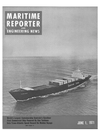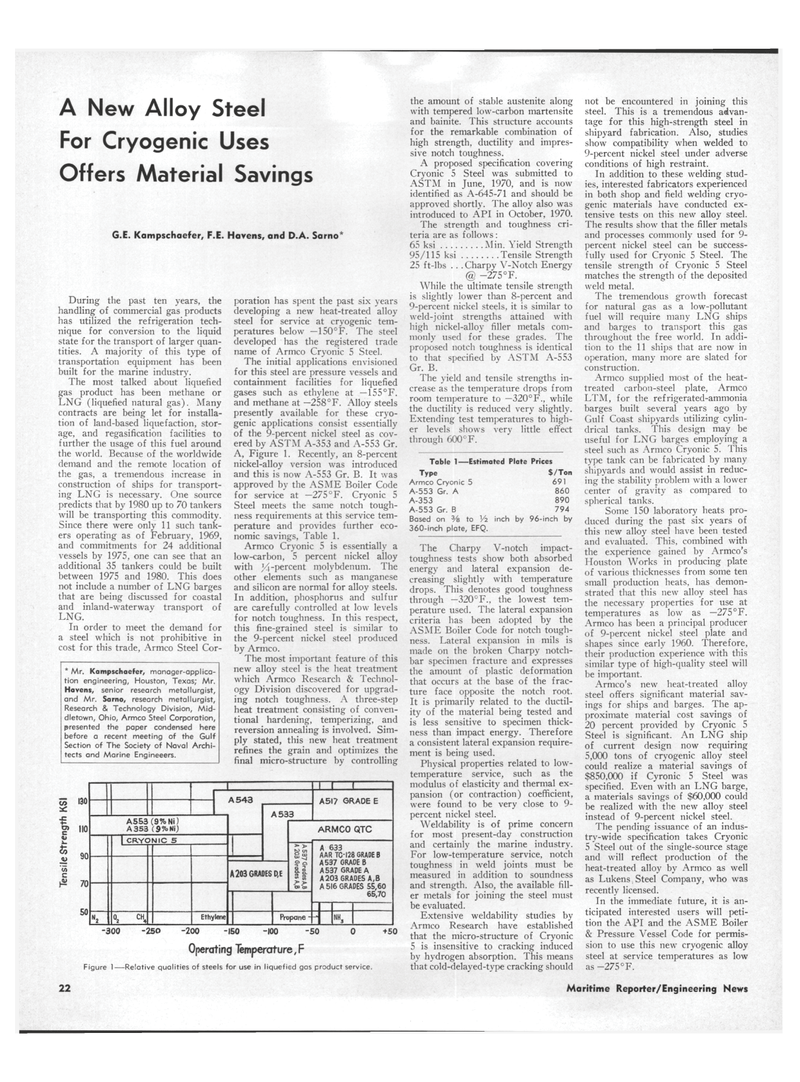
Page 20: of Maritime Reporter Magazine (June 1971)
Read this page in Pdf, Flash or Html5 edition of June 1971 Maritime Reporter Magazine
A New Alloy Steel
For Cryogenic Uses
Offers Material Savings
G.E. Kampschaefer, F.E. Havens, and D.A. Sarno*
During the past ten years, the handling of commercial gas products has utilized the refrigeration tech- nique for conversion to the liquid state for the transport of larger quan- tities. A majority of this type of transportation equipment has been built for the marine industry.
The most talked about liquefied gas product has been methane or
LNG (liquefied natural gas). Many contracts are being let for installa- tion of land-based liquefaction, stor- age, and regasification facilities to further the usage of this fuel around the world. Because of the worldwide demand and the remote location of the gas, a tremendous increase in construction of ships for transport- ing LNG is necessary. One source predicts that by 1980 up to 70 tankers will be transporting this commodity.
Since there were only 11 such tank- ers operating as of February, 1969, and commitments for 24 additional vessels by 1975, one can see that an additional 35 tankers could be built between 1975 and 1980. This does not include a number of LNG barges that are being discussed for coastal and inland-waterway transport of
LNG.
In order to meet the demand for a steel which is not prohibitive in cost for this trade, Armco Steel Cor- * Mr. Kampschaefer, manager-applica- tion engineering, Houston, Texas; Mr.
Havens, senior research metallurgist, and Mr. Sarno, research metallurgist,
Research & Technology Division, Mid- dletown, Ohio, Armco Steel Corporation, presented the paper condensed here before a recent meeting of the Gulf
Section of The Society of Naval Archi- tects and Marine Engineeers. poration has spent the past six years developing a new heat-treated alloy steel for service at cryogenic tem- peratures below —150°F. The steel developed has the registered trade name of Armco Cryonic 5 Steel.
The initial applications envisioned for this steel are pressure vessels and containment facilities for liquefied gases such as ethylene at —155°F. and methane at —258 °F. Alloy steels presently available for these cryo- genic applications consist essentially of the 9-percent nickel steel as cov- ered by ASTM A-353 and A-553 Gr.
A, Figure 1. Recently, an 8-percent nickel-alloy version was introduced and this is now A-553 Gr. B. It was approved by the ASME Boiler Code for service at —275 °F. Cryonic 5
Steel meets the same notch tough- ness requirements at this service tem- perature and provides further eco- nomic savings, Table 1.
Armco Cryonic 5 is essentially a low-carbon, 5 percent nickel alloy with J/J-percent molybdenum. The other elements such as manganese and silicon are normal for alloy steels.
In addition, phosphorus and sulfur are carefully controlled at low levels for notch toughness. In this respect, this fine-grained steel is similar to the 9-percent nickel steel produced by Armco.
The most important feature of this new alloy steel is the heat treatment which Armco Research & Technol- ogy Division discovered for upgrad- ing notch toughness. A three-step heat treatment consisting of conven- tional hardening, temperizing, and reversion annealing is involved. Sim- ply stated, this new heat treatment refines the grain and optimizes the final micro-structure by controlling
CO x: o» c «>
I— £ c i5>
A 633
AAR TC-128 GRADE B
A 537 GRADE B
A 537 GRADE A
A203 GRADES A,B
A 516 GRADES S5,60 65,70
Propane • -300 -250 -200 -ISO -100 SO 0
Operating Temperature^
Figure 1—Relative qualities of steels for use in liquefied gas product service. +50 the amount of stable austenite along with tempered low-carbon martensite and bainite. This structure accounts for the remarkable combination of high strength, ductility and impres- sive notch toughness.
A proposed specification covering
Cryonic 5 Steel was submitted to
ASTM in June, 1970, and is now identified as A-645-71 and should be approved shortly. The alloy also was introduced to API in October, 1970.
The strength and toughness cri- teria are as follows: 65 ksi Min. Yield Strength 95/115 ksi Tensile Strength 25 ft-lbs . . . Charpy V-Notch Energy @ -275 °F.
While the ultimate tensile strength is slightly lower than 8-percent and 9-percent nickel steels, it is similar to weld-joint strengths attained with high nickel-alloy filler metals com- monly used for these grades. The proposed notch toughness is identical to that specified by ASTM A-553
Gr. B.
The yield and tensile strengths in- crease as the temperature drops from room temperature to —320°F., while the ductility is reduced very slightly.
Extending test temperatures to high- er levels shows very little effect through 600°F.
Table 1—Estimated Plote Prices
Type $/Ton
Armco Cryonic 5 691
A-553 Gr. A 860
A-353 89
A-553 Gr. B 794
Based on % to Vi inch by 96-inch by 360-inch plate, EFQ.
The Charpy V-notch impact- toughness tests show both absorbed energy and lateral expansion de- creasing slightly with temperature drops. This denotes good toughness through —320°F., the lowest tem- perature used. The lateral expansion criteria has been adopted by the
ASME Boiler Code for notch tough- ness. Lateral expansion in mils is made on the broken Charpy notch- bar specimen fracture and expresses the amount of plastic deformation that occurs at the base of the frac- ture face opposite the notch root.
It is primarily related to the ductil- ity of the material being tested and is less sensitive to specimen thick- ness than impact energy. Therefore a consistent lateral expansion require- ment is being used.
Physical properties related to low- temperature service, such as the modulus of elasticity and thermal ex- pansion (or contraction) coefficient, were found to be very close to 9- percent nickel steel.
Weldability is of prime concern for most present-day construction and certainly the marine industry.
For low-temperature service, notch toughness in weld joints must be measured in addition to soundness and strength. Also, the available fill- er metals for joining the steel must be evaluated.
Extensive weldability studies by
Armco Research have established that the micro-structure of Cryonic 5 is insensitive to cracking induced by hydrogen absorption. This means that cold-delayed-type cracking should not be encountered in joining this steel. This is a tremendous advan- tage for this high-strength steel in shipyard fabrication. Also, studies show compatibility when welded to 9-percent nickel steel under adverse conditions of high restraint.
In addition to these welding stud- ies, interested fabricators experienced in both shop and field welding cryo- genic materials have conducted ex- tensive tests on this new alloy steel.
The results show that the filler metals and processes commonly used for 9- percent nickel steel can be success- fully used for Cryonic 5 Steel. The tensile strength of Cryonic 5 Steel matches the strength of the deposited weld metal.
The tremendous growth forecast for natural gas as a low-pollutant fuel will require many LNG ships and barges to transport this gas throughout the free world. In addi- tion to the 11 ships that are now in operation, many more are slated for construction.
Armco supplied most of the heat- treated carbon-steel plate, Armco
LTM, for the refrigerated-ammonia barges built several years ago by
Gulf Coast shipyards utilizing cylin- drical tanks. This design may be useful for LNG barges employing a steel such as Armco Cryonic 5. This type tank can be fabricated by many shipyards and would assist in reduc- ing the stability problem with a lower center of gravity as compared to spherical tanks.
Some 150 laboratory heats pro- duced during the past six years of this new alloy steel have been tested and evaluated. This, combined with the experience gained by Armco's
Houston Works in producing plate of various thicknesses from some ten small production heats, has demon- strated that this new alloy steel has the necessary properties for use at temperatures as low as —275 °F.
Armco has been a principal producer of 9-percent nickel steel plate and shapes since early 1960. Therefore, their production experience with this similar type of high-quality steel will be important.
Armco's new heat-treated alloy steel offers significant material sav- ings for ships and barges. The ap- proximate material cost savings of 20 percent provided by Cryonic 5
Steel is significant. An LNG ship of current design now requiring 5,000 tons of cryogenic alloy steel could realize a material savings of $850,000 if Cyronic 5 Steel was specified. Even with an LNG barge, a materials savings of $60,000 could be realized with the new alloy steel instead of 9-percent nickel steel.
The pending issuance of an indus- try-wide specification takes Cryonic 5 Steel out of the single-source stage and will reflect production of the heat-treated alloy by Armco as well as Lukens Steel Company, who was recently licensed.
In the immediate future, it is an- ticipated interested users will peti- tion the API and the ASME Boiler 6 Pressure Vessel Code for permis- sion to use this new cryogenic alloy steel at service temperatures as low as -275°F. 22 Maritime Reporter/Engineering News

 19
19

 21
21
